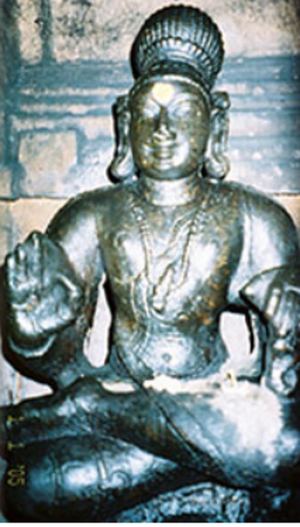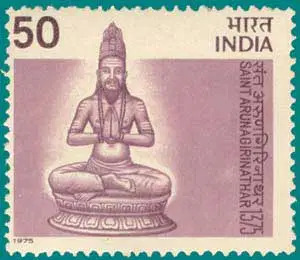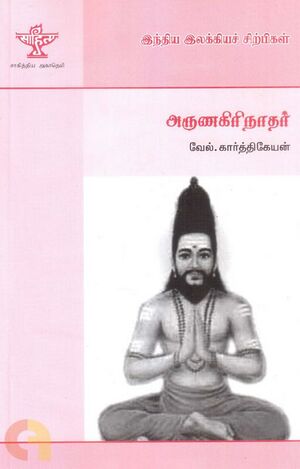Arunagirinathar
இந்தப் பக்கத்தை தமிழில் வாசிக்க: அருணகிரிநாதர்
Arunagirinathar is a Tamil devotional poet who lived in the 14th Century (CE). He wrote the celebrated Thiruppugazh[1]’, an anthology of song poems in praise of Lord Muruga. Thiruppugazh songs are set to complex meters and rhythmic patterns called Sandham, and occupy a prominent position in the Tamil musical tradition.
Profile
Arunagirinathar was born in a Kaikola Senguthar family in the year 1370 at Thiruvannamalai. The Arunagirinathar Puranam identifies his birthday in line with the Tamil lunar calendar and Vedic astrology as Purattasi Uttiram, Dhanur Lagnam - which places his birth roughly around the month of September-October, under the rising sign of Sagittarius. The names of his father and mother are believed to be Thiruvenkattar and Muthammai. Arunagirinathar’s father passed away when he was still a newborn. He was raised by his elder sister Aadhi. Arunagiri spent his youth gaining expertise in Tamil literary and grammatical works. He was also well versed in Sanskrit. Arunagirinathar was married at the appropriate age. Despite his many talents, he indulged in the company of prostitutes. As a result of his vice, he lost all his assets. His body took a heavy beating and he suffered from leprosy. Arunagirinathar's biographers note that Lord Muruga miraculously cured him of his diseases and freed him from debauchery. This lead his journey of writing bhakthi[2] poems.
In the song Manaiyaval Nagaikka[3] he speaks about being mocked by his parents, relatives and wife. This has lead the researchers to claim that he was married and that his parents lived with him for a considerable period of time. Lord Muruga at the Cheyyur Vedapureeswarar temple was his favorite deity.
Some place Arunagiri in the 15th century C.E based on his reference to King Prabuda Deva in the song Athala Sethanarada[4]. In this song, Arunagiri makes a reference to Lord Muruga residing in the joyously dancing mind of King Prabuda Deva who ruled Thiruvannamalai in the latter half of the 15th century.
Legend
After losing his health and wealth to his sexual indulgences, Arunagiri, unable to contain himself sought money from his elder sister, Aadhi, to indulge again. She responded, "Am I not a woman too?" Jolted and driven to shame by her question he reached atop the hills of Thiruvannamalai with the intention of jumping to death. Lord Muruga appeared in front of him and inscribed the syllables denoting Lord Muruga’s essence Sa ra va na bha va’. Legend says that enlightened by this experience, Arunagiri began writing Thiruppugazh, starting with the name of his mother in the song Muthai tharu pathi thirunagai[5].
Literary Life
Arunagirinathar was proficient in both Tamil and Sanskrit. Thiruppugazh, one of the seminal works of the Medieval period, comprises of about 16000 song poems. Arunagirinathar travelled across South India in the process of writing these. He has employed more than 1008 Sandham variations in these songs. Enriched with nuanced rhythms and rhyme schemes, Thiruppugazh is a synthesis of literature and devotion. Arunagirinathar has made multiple references to Ramayanam in Thiruppugazh. He has also exemplified about Hindu saint-poets such as Sundarar and Thirugnanasambandar. To the ardent devotees of Lord Muruga, Arunagiri’s works are comparable only to the great works of the Bhakthi poets[6]. They consider Thiruppugazh as the equivalent of Devaram, Kandar Alankaram as the equivalent of Thiruvasagam and Kandar Anuboothi of Thirumandiram.
Revival and Publication of Poems
In 1871, District Munsif V T Subramania Pillai came across a rendering of songs from Thiruppugazh at a discussion and was captivated by it. At that point, Thiruppugazh's manuscripts lay scattered and forgotten. Subramania Pillai toured extensively across South of India, collected manuscripts and handwritten texts, and published them in two volumes, the first in 1894 and the second in 1901. Post his demise, his son V S Chengalvaraya Pillai published a new edition of these books.
Biographies
- Arunagirinathar - Vel Karthikeyan - Sculptors of Indian Literature
- Arunagirinathar's divine life - M S Rasamanikkam
- Arunagirinathar - Life and Works - V S Chengalvaraya Pillai
- Arunagirinathar's biography - P Sri
- March of Arunagiri - Chitra Moorthi
Film
In 1964, a movie titled "Arunagirinathar" was released in Tamil. Playback vocalist T M Soundararajan played the title role.
Compositions
- Kandharandhadhi (102 songs)
- Kandharalangaram (108 songs)
- Kandharanubhuthi (52 songs)
- Thirupugazh (1307 songs)
- Thiruvaguppu (52 songs)
- Seval viruththam (11 songs)
- Mayil viruththam (11 songs)
- Vel viruththam (11 songs)
- Thiruvezhukootrirukkai
References
- Encyclopedia of Arunagirinathar, kaumaram.com
- History of Arunagirinathar, elathuranmikasapai blog
- Arunagirinathar, tamilandvedas.com
- History of of Arunagirinathar- review, Tamil hindu
- Arunagirinathar, Tamil Online
- History of Arunagirinathar, aanmeegam.co.in
Footnotes
✅Finalised Page



